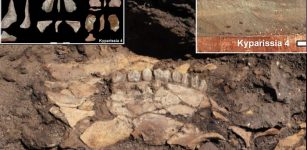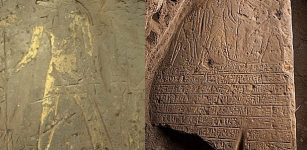Artifacts And Long History Of Unguja Island – Ancient Humans Impact Island’s Environment
Conny Waters - AncientPages.com - Unguja Ukuu is a small settlement on Unguja island (Zanzibar Island), in Zanzibar, Tanzania.
It is an archaeological site that has yielded abundant artifacts and evidence of the long history of Unguja Ukuu. Artifacts unearthed at Unguja Ukuu came from many places all over the world: pottery from the Far East, Near East, India, and the Southern Mediterranean region.
Other items such as rings, glass, coins, iron artifacts, and ivory have also been found along with a variety of animal remains.
Image credit: Flinders University
Visitors to Unguja Ukuu, centrally located off the east coast of Africa and at the edge of the Indian Ocean, left behind evidence that this place was a central trading port. Unlike the mainland, this site was influenced by foreign merchants and each of them left a mark on this site. Due to the trade activity here early urbanism is evident in one of the first east African trading posts.
Humanity’s impact on the environment is often framed in the context of the post-industrial era but new archaeological research reveals how intensive land use by a medieval East African population altered the natural habitat forever.
Unguja Ukuu, an archaeological settlement located on the Zanzibar Archipelago in Tanzania, was a key port of trade in the Indian Ocean by the first millennium when the island was populated by farming societies establishing trade links toward the Indian Ocean, China, and beyond.
Decorated brass artefact from Unguja Ukuu, Zanzibar (Photo: Ian Cartwright, University of Oxford).
New research published in the Journal of Island and Coastal Archaeology describes how human activities modified the shoreline at Unguja Ukuu.
Urban growth at the coastal settlements and trade ports on the island, and associated trade activities, may have silted up the lagoon hindering the sea traffic and ultimately impacting fish numbers and playing a part in the community’s decline.
For millennia, the Indian Ocean was the maritime setting for a budding form of globalization, with extensive trade and exchange networks operating between Eastern Africa, Southern Arabia, and Southeast Asia which foreshadowed modern global shipping networks.
Image credit: Flinders University
“The islands of the Zanzibar Archipelago witnessed numerous environmental and cultural changes as the region became a hub of maritime trade, cross-cultural interaction, and global exchange,” says the study’s lead author and Senior Lecturer in Archaeology at Flinders University, Dr. Ania Kotarba-Morley.
These changes resulted in the dumping of food remains, general waste, and increased agricultural activity and land use, all of which negatively impacted sediment build-up along the island.
“Whilst discussion about human impacts on the planet and its natural environments is ever-present in our current discourse, they almost always refer to the modern impacts and are focused on agricultural or urban areas such as large cities.
“Our study outlines clearly how human interference in a natural environment impacted coastal landforms and sediments on a remote East African island already over 1000 years ago and directly changed the fortunes of the coastal inhabitants in the area as a result,” says a senior author of the study Associate Professor Mike Morley of Flinders University
Written by Conny Waters - AncientPages.com Staff Writer
More From Ancient Pages
-
 Greek Discovery Of Stone Tools In Megalopolis Area Pushes Back Greece’s Archaeological Record Up To 250,000 Years
Archaeology | Jun 2, 2023
Greek Discovery Of Stone Tools In Megalopolis Area Pushes Back Greece’s Archaeological Record Up To 250,000 Years
Archaeology | Jun 2, 2023 -
 New Inscriptions, Gold And Paint Showed Thanks To Restoration In Temple Of Edfu
Archaeology | Sep 20, 2024
New Inscriptions, Gold And Paint Showed Thanks To Restoration In Temple Of Edfu
Archaeology | Sep 20, 2024 -
 Mysterious Undeciphered Ripley Scroll And Its Connection To The Philosopher’s Stone
Featured Stories | Mar 26, 2025
Mysterious Undeciphered Ripley Scroll And Its Connection To The Philosopher’s Stone
Featured Stories | Mar 26, 2025 -
 ‘Masters Of The Desert’ – Hohokam People, Massive Caliche Structures And Sophisticated Extensive Irrigation Canals
Civilizations | May 31, 2016
‘Masters Of The Desert’ – Hohokam People, Massive Caliche Structures And Sophisticated Extensive Irrigation Canals
Civilizations | May 31, 2016 -
 Great Easter Traditions Passed Down Over Centuries And Widely Practiced
Ancient History Facts | Mar 25, 2016
Great Easter Traditions Passed Down Over Centuries And Widely Practiced
Ancient History Facts | Mar 25, 2016 -
 Phurba Dagger: Magical Weapon That Restrains Evil And Harmful Occult Forces
Artifacts | Mar 16, 2019
Phurba Dagger: Magical Weapon That Restrains Evil And Harmful Occult Forces
Artifacts | Mar 16, 2019 -
 Mysterious White Mass On The Heads Of The Tarim Basin Mummies Identified
Archaeology | Oct 1, 2024
Mysterious White Mass On The Heads Of The Tarim Basin Mummies Identified
Archaeology | Oct 1, 2024 -
 12th Century Idol Of Vishnumurthy Unearthed In Abandoned Well Near Udupi, India
Archaeology | Feb 26, 2021
12th Century Idol Of Vishnumurthy Unearthed In Abandoned Well Near Udupi, India
Archaeology | Feb 26, 2021 -
![Horses in the Eurasian steppes: Already 5000 years ago, they served pastoralists as a source of milk and a means of… [more] © A. Senokosov](https://www.ancientpages.com/wp-content/uploads/2021/09/pastoraliststeppe15-307x150.jpg) Milk Enabled Massive Steppe Migration – A New Study
Archaeology | Sep 24, 2021
Milk Enabled Massive Steppe Migration – A New Study
Archaeology | Sep 24, 2021 -
 Reconstructed Roman Gateway Tells The Story Of Britain’s Invasion
Featured Stories | Aug 26, 2023
Reconstructed Roman Gateway Tells The Story Of Britain’s Invasion
Featured Stories | Aug 26, 2023 -
 Another Franklin Expedition Crew Member Identified
Archaeology | Sep 26, 2024
Another Franklin Expedition Crew Member Identified
Archaeology | Sep 26, 2024 -
 Yak Milk Consumption Among Mongol Empire Elites – New Study
Archaeology | Apr 1, 2023
Yak Milk Consumption Among Mongol Empire Elites – New Study
Archaeology | Apr 1, 2023 -
 Unravelling The Mystery Of The Ulfberht Sword – An Ancient Viking Artifact Far Ahead Of Its Time
Artifacts | Feb 11, 2014
Unravelling The Mystery Of The Ulfberht Sword – An Ancient Viking Artifact Far Ahead Of Its Time
Artifacts | Feb 11, 2014 -
 Hidden Treasures Revealed In Unique 3D Rendering Of Robber’s Cave In Nebraska
Archaeology | Dec 11, 2019
Hidden Treasures Revealed In Unique 3D Rendering Of Robber’s Cave In Nebraska
Archaeology | Dec 11, 2019 -
 Ancient Paintings Discovered At Kom Ombo Temple At Aswan, Egypt
Archaeology | Oct 4, 2018
Ancient Paintings Discovered At Kom Ombo Temple At Aswan, Egypt
Archaeology | Oct 4, 2018 -
 Mystery Of The Lost Continent Destroyed By An Ancient Cataclysm – Mysterious Islands – Part 2
Ancient Mysteries | Aug 16, 2021
Mystery Of The Lost Continent Destroyed By An Ancient Cataclysm – Mysterious Islands – Part 2
Ancient Mysteries | Aug 16, 2021 -
 Stele Of Tell al-Rimah And Deeds Of Assyrian King Adad-nirari Against Rebellious Kings
Featured Stories | Feb 22, 2022
Stele Of Tell al-Rimah And Deeds Of Assyrian King Adad-nirari Against Rebellious Kings
Featured Stories | Feb 22, 2022 -
 Pharaoh Merneptah – His Giant Sarcophagus And Unique Victory Stele
Featured Stories | Apr 17, 2018
Pharaoh Merneptah – His Giant Sarcophagus And Unique Victory Stele
Featured Stories | Apr 17, 2018 -
 Two Discoveries Reported From Komombo Temple And Elephantine Island, Aswan
Archaeology | Dec 9, 2017
Two Discoveries Reported From Komombo Temple And Elephantine Island, Aswan
Archaeology | Dec 9, 2017 -
 Bizarre Event – Why Did Hundreds Of Individuals Suddenly Freak Out At A Cemetery?
Featured Stories | May 30, 2023
Bizarre Event – Why Did Hundreds Of Individuals Suddenly Freak Out At A Cemetery?
Featured Stories | May 30, 2023



